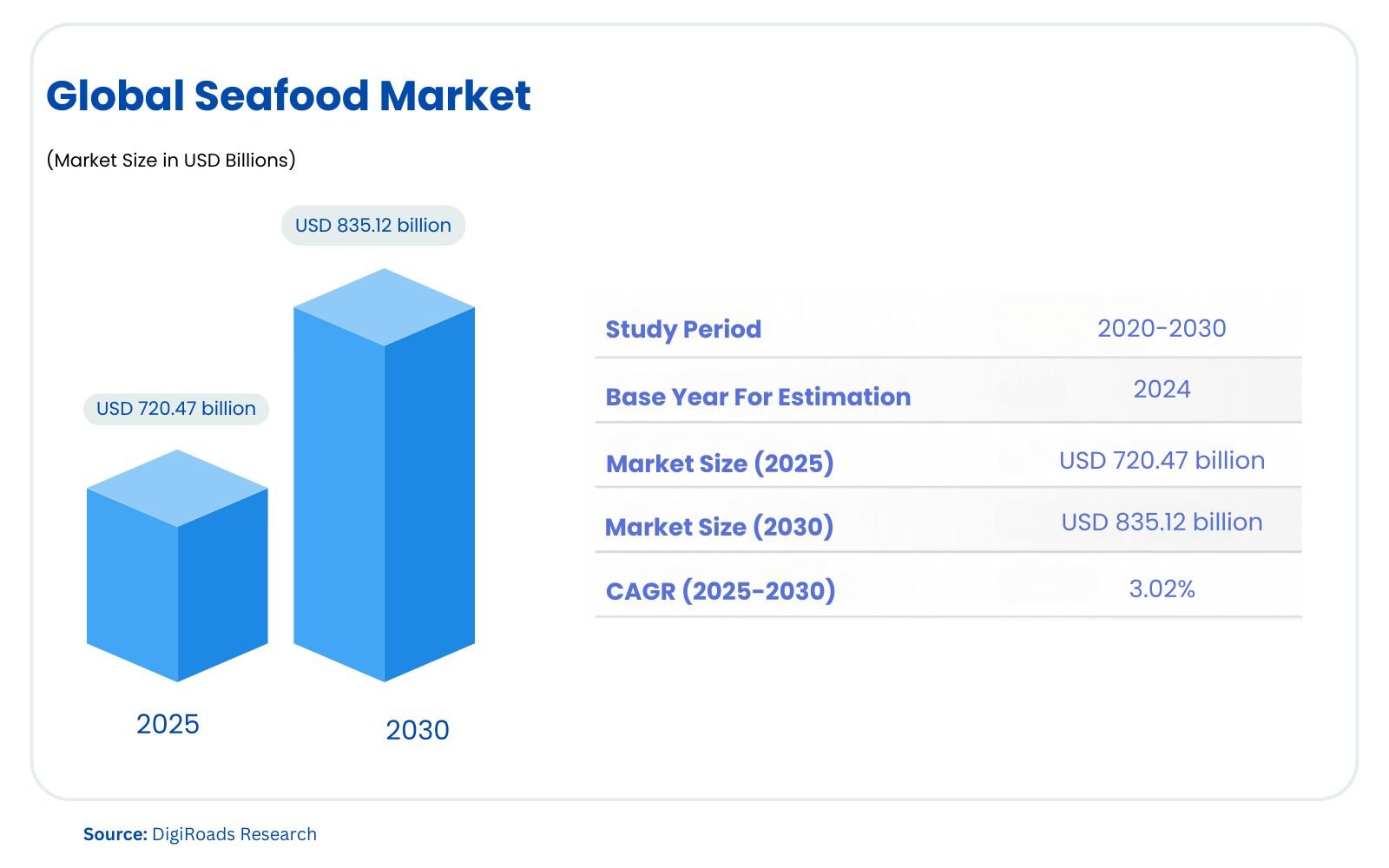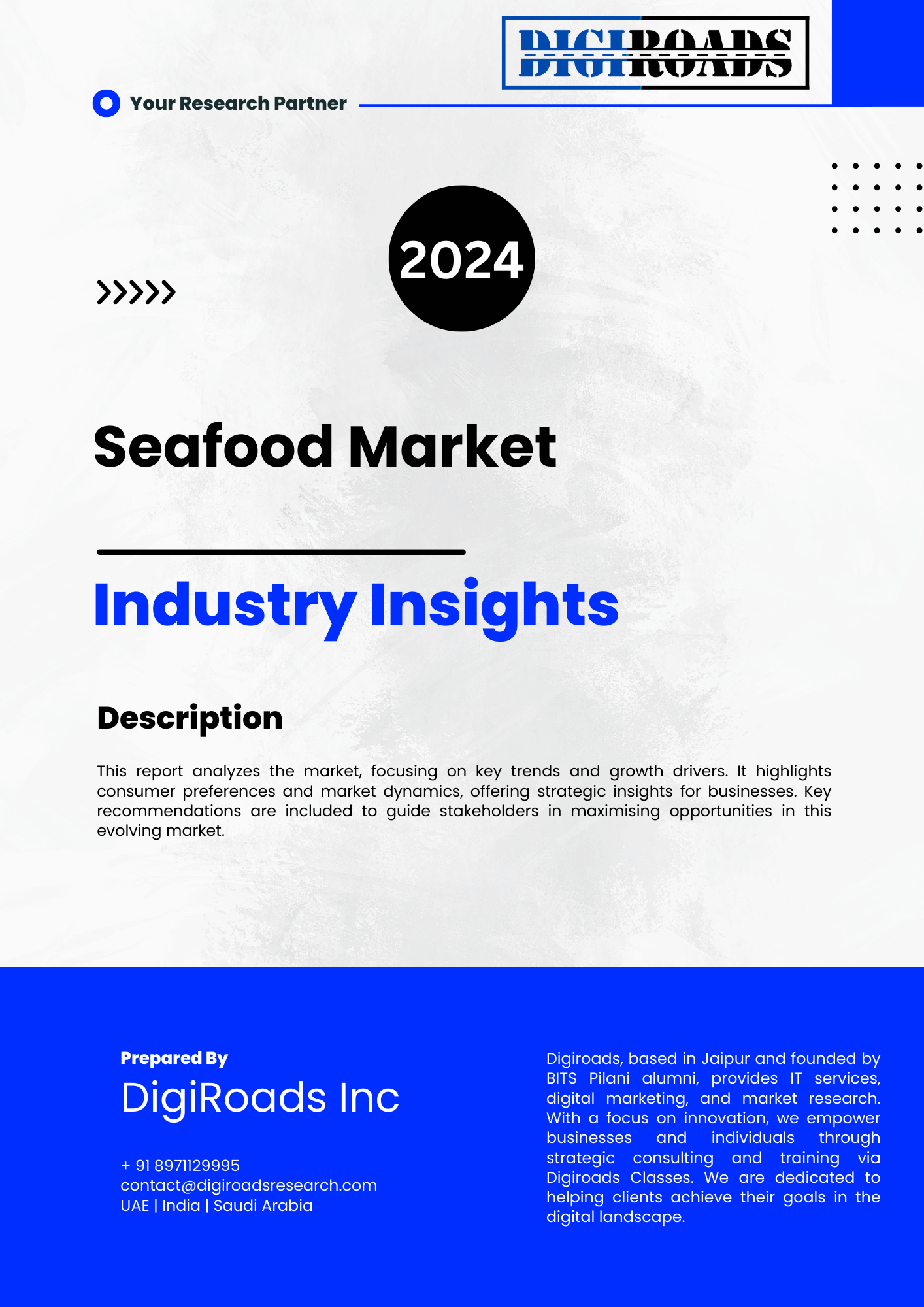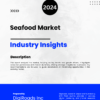Global Seafood Market
- Brand: DigiRoads
Global Food and Beverage Market Report on Seafood: This 100+ pages report provides in-depth insights into market trends, growth drivers, and competitive landscape. Available in PDF and Excel formats for comprehensive analysis and easy data access.
Global Seafood Market Report | Market Size, Industry Analysis, Growth Opportunities, & Forecast (2025-2030)
Global Seafood Market Overview
The global seafood market is poised for significant growth, with an estimated valuation of USD 835.12 billion by 2030, up from USD 720.47 billion in 2025. This steady expansion reflects a projected CAGR of 3.02% during the forecast period (2025–2030). Seafood remains a staple in global diets due to its rich nutritional profile, including omega-3 fatty acids, vitamins, and minerals, making it a preferred protein source for health-conscious consumers.
Key factors driving market growth include rising demand for sustainable seafood, advancements in aquaculture, and innovations like 3D-printed seafood that cater to personalized dietary needs. Countries like India lead the market due to increased exports and regional seafood preferences. Meanwhile, sustainability initiatives and certifications, such as MSC and ASC, continue to shape consumer choices worldwide.
Challenges, such as climate change, overfishing, and supply chain disruptions, pose risks to the industry. However, the rise of alternative protein sources and direct-to-consumer sales channels offers new growth opportunities. With robust innovation and sustainability efforts, the seafood market is set to thrive in the coming decade.
This report provides in-depth insights into market trends, opportunities, and challenges, tailored to help businesses succeed in the evolving seafood landscape.
Market Report Coverage:
The “Global Seafood Market Report—Future (2025-2030)” by Digiroads Research & Consulting covers an in-depth analysis of the following segments in the market.
| By Product Type | Pelagics, Tuna, Salmonids, Molluscs, Crustaceans, Lobsters, Crabs, Shrimp, Others |
| By Form | Fresh, Chilled, Frozen, Ambient |
| By Sales Channel | Direct, Indirect, Modern Trade, Convenience Stores, Specialty Food Stores, Wholesale Stores, Discount Stores, Online Retail |
| By Region | North America, Europe, Asia, Latin America, Middle East and Africa |
Study Assumptions and Definitions
The study on the global seafood market is based on key assumptions and industry-standard definitions to provide accurate and actionable insights. The market size, growth rate, and segmentation are derived using data from reliable sources, including industry reports, trade associations, government databases, and expert consultations. Historical data till 2024 and projections for 2025 to 2030 are used to analyze trends, with a focus on macroeconomic factors, consumer preferences, and technological advancements.
Seafood is defined as consumable aquatic organisms, including fish, mollusks, crustaceans, and other marine species, harvested through wild catch or aquaculture. The segmentation considers diverse forms (fresh, frozen, chilled, ambient), product types (ground fish, pelagics, crustaceans, etc.), and end uses (food, pharmaceuticals, cosmetics, etc.). Sustainable practices, certified by bodies like MSC and ASC, play a significant role in market dynamics.
Key assumptions include the stability of global trade policies, steady technological progress in aquaculture, and consistent consumer demand for high-quality protein sources. Emerging challenges like climate change, overfishing, and regulatory changes are considered, alongside opportunities such as plant- and cell-based seafood innovations. This study assumes robust demand in emerging markets and continued consumer focus on health, sustainability, and convenience.
Market Scope
The global seafood market encompasses a wide range of aquatic consumables, including fish, mollusks, crustaceans, and other marine species, sourced from both wild capture and aquaculture. This study examines the market dynamics across various forms, including fresh, frozen, chilled, and ambient seafood, alongside product types such as groundfish, pelagics, tuna, salmonids, mollusks, and crustaceans like shrimp, lobster, and crab.
The scope covers diverse end-use sectors, including food, pharmaceuticals, cosmetics, industrial applications, biotechnology, and household retail. It also includes various sales channels, such as direct sales, modern trade, convenience stores, specialty food outlets, wholesale, discount stores, online retail, and other retail formats.
Geographically, the study spans major regions, including North America, Latin America, Europe, East Asia, South Asia, Oceania, and the Middle East and Africa. Emphasis is placed on key trends like sustainability, technological advancements, and growing consumer demand for healthy, convenient, and ethically sourced seafood products.
MARKET OUTLOOK
Executive Summary
The global seafood market is poised for steady growth, projected to reach a valuation of USD 835.12 billion by 2030, up from USD 720.47 billion in 2025, reflecting a CAGR of 3.02% during the forecast period. Seafood continues to be a vital source of high-quality protein, rich in omega-3 fatty acids, vitamins, and minerals, driving consistent consumer demand globally.
Market Drivers:
The expanding tourism and hospitality sectors are boosting seafood consumption, particularly as seafood dishes become a staple in culinary experiences worldwide. Increasing consumer focus on health and wellness, combined with the nutritional benefits of seafood, is further bolstering demand. The growing popularity of specialized seafood delivery services and online retail channels is also enhancing market reach.
Emerging Trends:
Technological innovations like 3D printing are revolutionizing the market by enabling the production of personalized seafood alternatives, including plant- and cell-based products. Sustainability remains a key focus, with certifications from bodies like MSC and ASC gaining prominence as consumers seek eco-friendly and ethically sourced options.
Geographical Insights:
Markets in India and China are witnessing significant growth, driven by robust aquaculture and rising affluence, while the U.S. market emphasizes sustainability and convenience. Conversely, Japan’s market shows sluggish growth due to changing consumer lifestyles.
Challenges:
Climate change, overfishing, regulatory hurdles, and contamination risks pose challenges to market sustainability and supply chain stability.
Overall, the global seafood market offers lucrative opportunities for players focusing on innovation, sustainability, and expanding into untapped markets while addressing environmental and ethical concerns.
COMPETITIVE LANDSCAPE
The global Seafood Market is moderately fragmented, with regional and multinational players competing fiercely for market share.
Key Market Players
- Amalgam Frozen Foods Pvt. Ltd.
- American Seafoods Company
- Austevoll Seafood ASA
- Cooke Inc.
- Dongwon F&B
- Faroe Seafood
- Handy Seafood Inc.
- Hansung Enterprise Co. Ltd.
- High Liner Foods Incorporated
- Kangamiut Seafood A/S
Market Share Analysis
The global seafood market exhibits a fragmented structure, with key players dominating specific segments like aquaculture, wild-caught seafood, and value-added products. The market’s fragmentation stems from the diversity of seafood species and forms, ranging from fresh and frozen to processed and ambient options.
Companies like Thai Union Group PCL, Mowi ASA, and High Liner Foods Incorporated hold significant market shares due to their extensive global operations and diverse product portfolios. Thai Union is a leader in canned seafood, while Mowi excels in salmon farming, and High Liner focuses on frozen products.
Regional dominance varies: China leads in seafood production and consumption due to its robust aquaculture industry, while the U.S. and Europe prioritize sustainable and premium seafood options. Companies like Pacific Seafood and Trident Seafoods Corporation dominate the North American market with a focus on convenience and traceability.
Emerging markets like India are growing rapidly, with players such as Amalgam Frozen Foods Pvt. Ltd. capitalizing on increasing exports and domestic demand.
Sustainability and innovation play critical roles in shaping market shares, with certified products gaining favor among consumers. Companies investing in 3D-printed seafood, plant-based alternatives, and eco-friendly practices are expected to secure larger market shares in the future.
MARKET DYNAMICS
Market Drivers and Key Innovations
- Health and Wellness Trends: Increasing consumer awareness about the health benefits of seafood, particularly its high omega-3 fatty acid content, has led to growing demand. Seafood is considered a lean, nutritious protein source, contributing to cardiovascular health and overall well-being.
- Sustainability and Ethical Sourcing: Sustainability is a major market driver, with consumers and retailers demanding ethically sourced seafood. Certifications like MSC (Marine Stewardship Council) and ASC (Aquaculture Stewardship Council) are gaining importance, prompting businesses to adopt eco-friendly practices.
- Tourism and Hospitality Growth: The rise in global travel and tourism has significantly boosted seafood consumption. Hotels, restaurants, and resorts are increasingly offering seafood dishes, catering to travelers seeking local culinary experiences.
- Convenience and Delivery Services: The increasing demand for convenience is driving the growth of online seafood delivery services, which provide fresh and varied seafood options directly from fishermen or aquaculture farms to consumers’ doorsteps.
Key Innovations
- 3D Printing of Seafood: This innovative technology allows for the creation of seafood products that mimic the texture, flavor, and appearance of traditional seafood. It also facilitates the production of plant-based and cell-cultured seafood alternatives, providing a sustainable and ethical option for consumers.
- Sustainable Packaging: Advancements in eco-friendly packaging, such as seaweed-based and biodegradable materials, are reducing the environmental impact of seafood products, aligning with consumer preferences for sustainability.
- Marine Biotechnology: Innovations in marine biotechnology have led to the development of algae-based supplements and other functional ingredients, adding nutritional value to seafood products.
Market Challenges
- Environmental Impact: Climate change, habitat degradation, and ocean pollution threaten the availability of seafood and disrupt ecosystems, impacting fisheries and aquaculture.
- Overfishing and Bycatch: Overfishing remains a significant issue, leading to depletion of marine resources. Bycatch, the unintended capture of non-target species, further exacerbates the problem, threatening biodiversity.
- Supply Chain Disruptions: The seafood supply chain is vulnerable to disruptions from factors like pandemics, natural disasters, and trade barriers, which can lead to shortages, increased costs, and delays in product availability.
- Regulatory Challenges: Stringent regulations regarding fishing practices, environmental standards, and trade restrictions, especially after Brexit, can create obstacles for seafood companies seeking to maintain operations across multiple regions.
- Health Concerns and Contamination: Seafood contamination due to foodborne diseases or harmful chemicals can damage consumer confidence, posing risks to both public health and the reputation of seafood brands.
- Cost Volatility: The fluctuating prices of raw materials, fuel costs for fishing vessels, and labor shortages can lead to price instability, which may impact both production costs and consumer prices.
- Consumer Preferences Shifting: Changing dietary habits, including the rising demand for plant-based and alternative protein sources, may challenge traditional seafood consumption patterns.
- Sustainability Certification Pressure: Increasing pressure on seafood producers to obtain sustainability certifications can create additional costs and operational challenges for businesses, especially small-scale producers.
Market Opportunities
- Plant-Based and Cell-Cultured Seafood: The growing demand for alternative protein sources presents opportunities for innovation in plant-based and cell-cultured seafood, catering to ethical and sustainability-conscious consumers.
- E-commerce Growth: The rise of online retail platforms and direct-to-consumer sales channels allows seafood businesses to reach a larger, more diverse customer base and offer convenience with home delivery services.
- Sustainable and Ethical Practices: With consumers increasingly valuing sustainability, there is a significant opportunity for companies to adopt environmentally friendly practices, such as ethical sourcing and eco-friendly packaging, to meet market demand.
- Emerging Markets: Rising affluence in emerging economies, especially in Asia, offers a large untapped market for seafood products, with increasing demand for premium and health-focused seafood options.
- Health-Focused Products: The popularity of health-conscious foods creates an opportunity for the development of value-added seafood products enhanced with omega-3s, probiotics, antioxidants, and other functional ingredients to meet consumer wellness needs.
- Technological Advancements: Innovations like 3D printing of seafood and advancements in marine biotechnology open new doors for product diversification, customization, and sustainability in seafood production.
- Sous Vide and Premium Seafood: The growing trend of gourmet and convenience cooking methods, such as sous vide, offers opportunities for premium and ready-to-cook seafood products that appeal to consumers seeking high-quality meals with minimal preparation.
- Seaweed and Algae-Based Products: The increasing use of seaweed for various applications, such as sustainable packaging, biofuels, and food supplements, creates opportunities for seafood companies to diversify and innovate their product offerings.
RECENT STRATEGIES & DEVELOPMENTS IN THE MARKET
Sustainability Focus:
- Wild Planet Foods, a key player in sustainably sourced seafood, added five new seafood products to its range at Whole Foods Market in the U.S. in July 2023. These products emphasize sustainability, catering to health-conscious and environmentally aware consumers.
Innovations in Seafood Production:
- Companies are investing heavily in 3D printing technology, allowing the production of seafood alternatives with customized textures, flavors, and appearance. This is especially important for developing plant-based and cell-cultured seafood substitutes.
- Innovations like algae-based omega-3 supplements are gaining traction as part of marine biotechnology advancements, appealing to consumers seeking functional food products.
Digital Transformation:
- The growing adoption of e-commerce platforms for seafood sales is reshaping the market. Online delivery services are enhancing accessibility and convenience, catering to consumers demanding fresh seafood at home.
Sustainability Certifications:
- More companies are striving to obtain certifications like Marine Stewardship Council (MSC) and Aquaculture Stewardship Council (ASC), ensuring sustainable sourcing practices. These certifications enhance credibility and appeal to eco-conscious consumers.
KEY BENEFITS FOR STAKEHOLDERS
For Seafood Producers:
- Increased Market Reach: Access to new markets through e-commerce platforms and retail expansions, helping to diversify revenue streams.
- Sustainability Recognition: Achieving certifications like MSC and ASC can enhance brand image and appeal to environmentally conscious consumers.
- Innovation Opportunities: Adoption of new technologies such as 3D printing and plant-based seafood alternatives allows for product differentiation and the ability to cater to evolving consumer preferences.
For Consumers:
- Variety of Products: Consumers benefit from a wide range of seafood options, including fresh, frozen, plant-based, and 3D-printed seafood, tailored to diverse tastes and dietary preferences.
- Health and Wellness: Access to nutrient-enriched seafood products with added benefits like omega-3s, probiotics, and antioxidants, contributing to better overall health.
- Convenience: Easy access to seafood via online retail and direct-to-consumer channels, providing fresh products delivered to their doorstep with minimal hassle.
For Retailers and Distributors:
- Competitive Advantage: Partnering with sustainable and innovative seafood producers enhances product offerings and attracts customers who prioritize ethical sourcing and sustainability.
- Consumer Loyalty: Retailers offering sustainable and high-quality seafood are likely to build stronger relationships with eco-conscious consumers, fostering long-term loyalty.
- Market Expansion: Retailers and distributors can tap into emerging markets, especially in regions like Asia, where rising affluence and demand for premium seafood present growth opportunities.
For Regulators and Certifying Bodies:
- Promoting Sustainability: Encouraging seafood businesses to adopt sustainable practices and acquire certifications supports environmental conservation efforts and ensures the long-term viability of marine ecosystems.
- Improved Industry Standards: Ongoing developments in sustainability and ethical sourcing practices raise the overall standards of the seafood industry, ensuring healthier ecosystems and better resource management.
At DigiRoads Research, we emphasize reliability by employing robust market estimation and data validation methodologies. Our insights are further enhanced by our proprietary data forecasting model, which projects market growth trends up to 2030. This forward-thinking approach ensures our analysis not only captures the current market landscape but also anticipates future developments, equipping stakeholders with actionable foresight.
We go a step further by offering an exhaustive set of regional and country-level data points, supplemented by over 60 detailed charts at no additional cost. This commitment to transparency and accessibility allows stakeholders to gain a deep understanding of the industry’s structural and operational dynamics. By providing exclusive and hard-to-access data, DigiRoads Research empowers businesses to make informed strategic decisions with confidence.
In essence, our methodology and data delivery foster a collaborative and data-driven decision-making environment, enabling businesses to navigate industry challenges and capitalize on opportunities effectively.
Contact Us For More Inquiry.
Table of Contents
-
INTRODUCTION
- Market Overview
- Years Considered for Study
- Market Segmentation
- Study Assumptions and Definitions
- Market Scope
-
RESEARCH METHODOLOGY
-
MARKET OUTLOOK
- Executive Summary
- Market Snapshot
- Market Segments
- By Form
- Fresh
- Chilled
- Frozen
- Ambient
- By Product Type
- Ground Fish
- Pelagics
- Tuna
- Salmonids
- Molluscs
- Crustaceans
- Lobsters
- Crabs
- Shrimp
- By Region:
- North America
- Europe
- Asia
- Latin America
- Middle East
- Africa
- By Form
-
COMPETITIVE LANDSCAPE
- Recent Strategies (Key Strategic Moves)
- Market Share Analysis
- Company Profiles
- Amalgam Frozen Foods Pvt. Ltd.
- American Seafoods Company
- Austevoll Seafood ASA
- Cooke Inc.
- Dongwon F&B
- Faroe Seafood
- Handy Seafood Inc.
- Hansung Enterprise Co. Ltd.
- High Liner Foods Incorporated
- Kangamiut Seafood A/S
- Leroy Seafood Group
- Mowi ASA
- Pacific Seafood
- Phillips Foods Inc.
- Thai Union Group PCL
- Tri Marine International Inc.
- Trident Seafoods Corporation
- Young’s Seafood Limited
- Zhangjiang Guolin Aquatic Products Co. Ltd.
-
MARKET DYNAMICS
- Market Drivers
- Market Challenges
- Market Opportunities
- Porter’s Five Forces’ Analysis
- Bargaining Power of Suppliers
- Bargaining Power of Buyers
- Threat of New Entrant
- Threat of Substitutes
- Competitive Rivalry
-
GLOSSARY OF PROMINENT SECONDARY SOURCES
-
DISCLAIMER
-
ABOUT US


